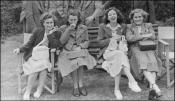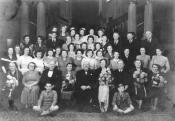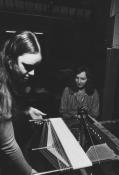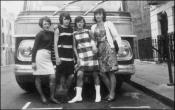Browse the interviews
Sorted by factory location
Glyncorrwg: Christie and Tyler's
VSE055 Caroline Isina Aylward, Louis Edwards, Maesteg;Christie and Tyler's, Glyncorrwg
Caroline left school at 15 (1952) and started in Louis Edwards. She worked there until she had her son - 1959. Before she started they made army uniforms but she was making evening gowns and lots for M&S. She sewed the collars mostly. Description of factory layout. Men/women balance. No talking, Dancing. Perks from factory – buy dresses with flaws. Garment Workers’ Union and paying on a Friday. Very hard work – Chinese labour. Time and motion on new styles – pricing jobs. Needles in fingers. She caught her skirt in a machine – so they had overalls after. Played netball after work a few times. She returned for a couple of years later (c. 1967-9) and a happier place. First time the workforce was disgruntled. She also worked in furniture factories - Colonial / Christie Tyler. She worked part-time when her son was small. Thicker material but earning good money. Easier sewing – not fussy. Describes processes. Moved to Trefforest (1980s?) when shortage of work in Glyncorrwg. Same company but different names to factories. Then she was aked to work with a designer as a machinist developing furniture She did private sewing for one of the male workers. Later factory in Glyncorrwg closed and they went to Pendragon in Bridgend. But made redundant and she went into Social Services.Goodwick: Slimma-Dewhirst
VSW024 Anonymous, Slimma-Dewhirst, Goodwick
The speaker left school at 15 (1970) and went to work in Slimma’s Cardigan, following an open day at her school. She was given a machine test. She started in waistbands, then on to pockets. They had to keep up with their line or it would affect everyone’s pay. She lagged behind because she was left-handed. Tiring and tedious but skilled work. She stayed 33 years. Pressers (men) paid more than machinists. The union and disputes about working conditions. Over-locking and fire threading were dirty jobs.. Not qualified as a machinist until you have a needle through your finger. Health and Safety. Recording work on tickets. She had hearing problems – she turned her hearing aid off on the factory floor. She has a deteriorating disk form sitting all day. Xmas time was pandemonium. Everyone was on best behaviour for the M&S visits. She was devastated when she was made redundant – she misses going to work.VSW022 Anonymous, Slimma-Dewhirst, Goodwick
The speaker left school at 16 (1978) and started in Slimma’s – the manager had visited her school and offered her a sewing job. She started on bar-tacking, progressed to turning garments and then the loop machine. It was difficult. The factory was noisy and hot. Discounts in factory shop c. 50% for trousers, cardigans and shoes. Help with reaching targets. Lack of sympathy when she needed leave. She felt proud she made clothes for M&S. She lost a nail in a machine – compensation. Health and Safety – no bags on the floor, no coats on the back of chairs. Not allowed to talk – it would affect targets. She was given a mask because of the dust. Blowing and polishing her machine. Made redundant when factory closed – 2002 – this was a shock and she hasn’t worked since. She received a watch for 20 years’ service.VSW023 Caroline Bowen, Slimma-Dewhirst, Goodwick
Caroline left school at 15 (1983) and worked in several places – gardening, hotel management and on the ferry before replying to a Slimma advertisement (c.1993) . She felt the women were bitchy and the factory environment cliquey. She worked on jeans but had difficulty keeping up with her quota. She was reprimanded. She provided her own expensive scissors c. £12 every 4 weeks. Her hands became sore- everyone strapped their hands. Moved to make boxer shorts. She fell in the factory and lost her job. She returned to work in the canteen. Headaches and chest complaints on the factory floor. She hated the work. She was at the bottom re status there. Baby showers and ribbons to mark time. Box of chocolates at Xmas time. Too hot or too cold. Radio 2 and sing alongs. Three week annual leave. Hampers brought in for Xmas celebrations. She suffered miscarriages – the effect of strain and stress in the factory? It was ‘hell’ there.Gorseinon: Myfanwy Products
VSW020 Rita Davies & Meirion Campden, Croydon Asbestos, Milford Haven;Myfanwy Products, Gorseinon;Glanarad Shirt Factory, Newcastle Emlyn
Rita and Meirion left school at 14 (1945 and 1949 respectively). Rita started immediately in the shirt factory and left to get married (1954) but returned after three years and Meirion joined her (c.1949-1995). The boss was Johnny Morgan, brother of the owner of J T Morgan’s warehouse, Swansea. The first job was hemming woollen shirts. They had pocket money from their pay packet. The boss would tap them on their heads or pinch them if they talked. Rita worked on the button machine and Meirion made shirts. They had a book to record their work. The factory was taken over by Myfanwy Products, Gorseinon – they made dolls’ clothes and shawls for 2-3 years. Then by Croydon Asbestos making leather gloves (Heavy work) with industrial machines. The older women were kind to them. They had a piece of clothing from the J T Morgan warehouse as a gift every Xmas and a trip to Llandrindod in June. The workers’ numbers were put on each shirt. Meirion had to go to hospital after sewing her finger. Rita went to work in rollers and a turban. Croydon Asbestos closed c.1996.

Gripoly Mills: Lewis & Tylor Ltd
VSE051 Jill Williams, Lewis & Tylor Ltd, Gripoly Mills
Jill left school at 16 (1968) and started in Lewis and Tylor. She found the noise unbelievable (electrical and manual looms) and cried at the thought of working there. She stayed there 10+ years. She also did home work repairing belts. She describes and explains the skilled work in great detail. Calluses on her hands – no gloves. It was like rowing. Caring – wedding gifts etc. One group made rubberised belts on smaller looms. The men made pipes and hoses for aeroplanes. After having the children she worked part-time there. The story about the foreman and his dog. Piecework and doing quota of belts. Some rushing and poor quality of belts. Describes bouncing up and down when weaving. Some dangers – tripping, weights falling, Helping one another. They all liked one particular loom – made better quality belts. She wanted to keep her own wires – during the holidays the foreman would wrap them up for her. Different patterns – plain, purl, herringbone etc. She took a record player into work. Her clocking-in number was 60. Trips and great fun. Later there were many Indian (Kenya) workers – TB a problem and the factory was closed for a time. Story of one arranged marriage. She worked as a dinner lady too – story of the bag of money. Her mother and father’s work. She shows the measure and the needles she had. Effect on hearing. Further details of technique.Part of this interview is available as an audio file

Gwynfe: Deva Dogware
VSW017 Nan Morse, Deva Dogware, Gwynfe;Alan Paine, Ammanford
Nan left school at 15 (1965) and started in Deva Dogware that summer. She cut the chains, welded etc, to make leads for dogs and dogs for the blind. It was a small factory and the owner was one of them. There was quite a bit of noise and singing there. She wore old clothes and goggles. They raced to make 50 chains. There weren’t many work opportunities in the countryside. Some workers went up to Crufts. They also made belts for themselves and gaffs for catching salmon. The building was primitive. She learned skills such as using a hammer and saw. She went on trips to Blackpool and London, where she bought white boots. She was in a Welsh pop group with other workers. She left c.1968. She moved to work in Alan Paine's but she didn’t like the factory atmosphere there, where they made jumpers. She left when she became pregnant.
VSW018 Enid Davies a Bronwen Williams, Deva Dogware, Gwynfe;Croydon Asbestos, Milford Haven
Enid left school at 16 (1965) and Bronwen at 16 (1964). Lack of transport meant it was difficult to find work if you lived in the country. Enid joined her brother in Milford Haven. Worked on picking potatoes and then in Croydon Asbestos (c.1966-68/9). She finished off leather gloves. Target – finishing 3200 gloves a week – a minute per glove. They were given premium bonds with their wages. Good working conditions: no side effects from asbestos. Bronwen looked after children before starting in Deva Dogware and she had left Deva Dogware before Enid started (c.1966-68). The working conditions were poor in DD but the workers facilitated the work. Enid made slip collars for dogs. She liked the mess. She remembers welding by gas; exporting the collars; listening to Wimbledon on the radio. Enid helped sell collars at Crufts – there were important people there. Poor conditions at Deva Dogware. Enid left to have a child, then returned until the factory closed (c. 1968/9-1972).Hereford: Thorn Electronics
VSE010 Brenda Mary Farr, Thorn Electronics, Hereford;Dressing Gown factory, Blaenavon;HG Stone Toy Factory, Pontypool
Mary left school at 15 (1956) – didn’t want to work in factory – wanted work in an office. But she found herself in HG Stone factory making soft toys - teddies and pandas etc– she worked on the line as a machinist. Piecework. Very big, noisy and dusty. Stuffed with straw or flock. Time and motion pricing time on each toy. Worker’s Playtime on the radio. Finished there in 1964. The women producing teddy bears got more than the others – specialist job. Wasn’t promoted because she talked too much. Also made dolls – plastic bodies and stitching on hair. Also dogs on wheels. Needles through fingers. Men’s work – on plastic and machines. Xmas dances with band. After 8 years in HG Stone spent 6 weeks in dressing gown factory in Blaenafon – couldn’t bear the smell of candlewick. When married she moved to Herefordshire – worked in Thorn Electrics making street lights. Lots of families in HG Stone (later Chad Valley) factory.Part of this interview is available as an audio file
